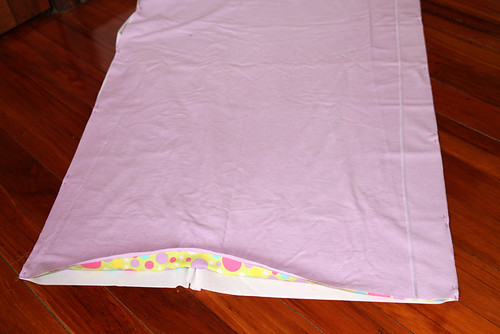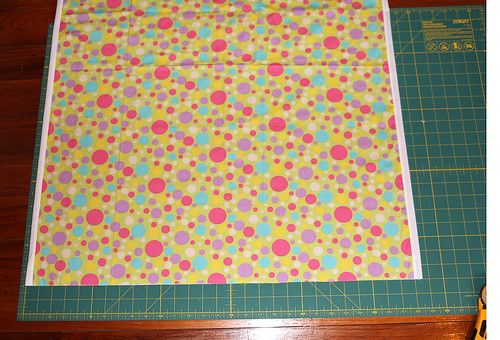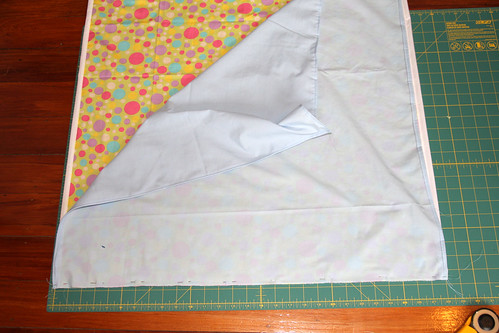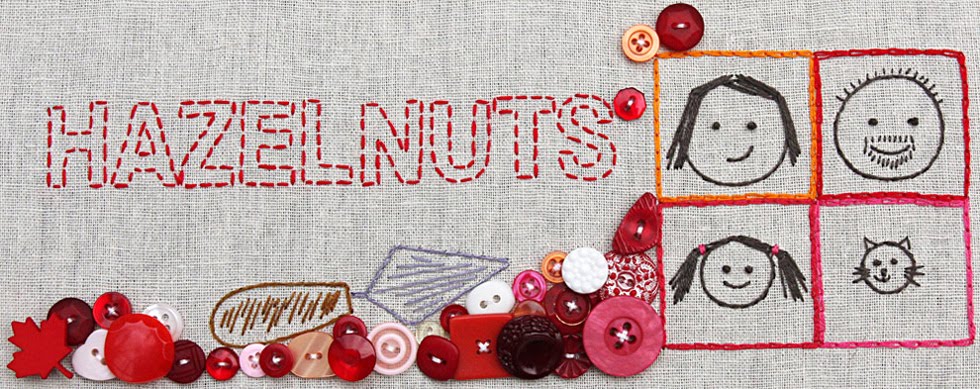
I gave away one of them not long ago because she just wasn't having any accidents, and wouldn't you know it she went through a 'phase' so I made up another one (and now the phase seems to be over!). I thought it might be useful to document the process because they're really very simple to make and doing it yourself is not only cheaper but you have your choice of fabulous fabrics! Essentially what you have is a cotton top and a waterproof PUL bottom (which rolls around the edges to the top and stops moisture leaking off the edges), with a slightly absorbant inner layer. It's held onto the bed by long flaps which tuck well under the mattress and hold it firm.
What you'll need:
1 x top fabric in 100% cotton
1 x inner absorbent fabric
1 x PUL fabric
2 x fabric for side flaps
A note on the fabrics: Choose good quality 100% cotton for the top, if the fabric has a synthetic component it won't absorb the liquid as quickly, if at all, meaning it's more likely to run off the top and onto the bed. I've used quilting cotton for my sheets. You could use a variety of absorbent fabrics for the inner, in this case I used an old piece of flannel. It doesn't need to hold the moisture for long, just enough time for you to get the sheet off the bed. Finally, the PUL - this is the polyurethane laminated woven fabric that is used in modern nappies/diapers, it's waterproof, thin and flexible and easily washed. It's readily available online from nappy making supply stores and it comes in a rainbow of colours and patterns. I've gone for boring old white because I like the clean edges it gives on the finished sheet. It might be a functional item but they can be aesthetically pleasing! My flaps are made from old polycotton sheets I had hanging around - whatever you've got that is big enough will suit!
A note on sewing with PUL: PUL can sometimes be tricky to sew as it is slippery on one side and has a tendency to stretch. Making sure the shiny side is down when sewing makes a huge difference, the presser foot just doesn't seem to move over it well. If you need to pin, make sure you pin within the seam allowance as any holes outside that will compromise the waterproofness. Use a nice sharp needle too. It's not too bad on this project as it's all straight lines. Overlockers/sergers are handle it brilliantly, although again, make sure it's shiny side down.
*All photos can be viewed in a larger size by clicking through to Flickr and selecting the original size from the 'all sizes' option.
1. First off measure your bed to determine fabric amounts. The cotton, inner and PUL need to be as wide as the bed top plus 2cm (1") for seam allowances. The depth (top-to-bottom measurement) is up to you, the one I made is 70 cm (28") largely because that's the size of the piece of PUL I had left over. Slightly narrower is fine, although you begin to run the risk of the child being off the sheet when the accident occurs. The PUL needs to be 5-6cm (approx. 2-2 1/2") deeper than the cotton and inner fabrics in order to be able to roll up and over the edge. In order to figure out the flap size, measure from the top edge of the bed, down the side and to about half way across the bottom of the mattress. Then add 3cm (1 1/4") for seam allowance and a hem on the far edge. This is your width. For the depth you need to figure out what the finished measurement of the cotton/inner plus the PUL edging will be and add 4cm (1 1/2") for hems. The seam allowances are up to you - I've allowed 1cm (1/2"), and for hemming 2cm (3/4").
The measurements for my single bed sheet are as follows:
Cotton and flannel: 99cm wide and 71 cm deep
PUL: 99cm wide and 76 cm deep
Flaps (x2): 72 cm wide and 73 cm deep
2. Putting it together. Layer the cotton, inner and PUL in this order: PUL shiny side (waterproof) down, then cotton right side down, then inner (in this case right side down because I had to sew two bits together and wanted the seam away from the top). Align the fabrics down one edge - there will be excess PUL sticking out the opposite side. Pin, taking care that they stay within the seam allowance. Shift top fabrics over and align edges with other PUL edge. You will have loose PUL in the middle (see photo below). Sew both edges with a 1cm (1/2") seam to form a tube.

3. Turn right side out so that the fabric side of the PUL is facing down and the cotton is right side up. Edge stitch with the seam allowance on the PUL side. This is one time when you shouldn't iron as you go - it's not good for the PUL! Just pull the seam flat from either side as you stitch.

4. Get the tube sitting nice and flat and then square off the edges. You can see in the photo below how the PUL is wrapped around the edges.

5. Hem up the side flaps making sure they match the finished depth of the tube. I fold the edge and then fold again to give a neat appearance.
6. Pin the flaps to either end of the tube, right sides together, and sew with a 1cm (1/2”) seam. If the PUL is shifting around too much you may want to tack the tube closed within the seam allowance first. Finish the seam by zigzagging if you haven't used an overlocker.

7. Edge stitch with the seam allowance on the flap side.

8. And you're done! This sheet had been on Hazel's bed for 2 days and hasn't shifted at all.

As the sheet is used and laundered you may notice the top fabrics shrinking a bit, making the PUL slightly looser. I find that just tugging them back into shape takes care of that to a large extent. Ironing PUL isn't recommended (it can melt), but you can safely put them through a dryer as long as it doesn't get too hot.
ETA: I forget that people don't know what PUL is because I lived and breathed PUL nappies for a couple years while Hazel was wearing them, it seems second nature! I found this good link to a more comprehensive explanation of what PUL is than mine, and the lady sells it by yard too. I'm afraid I'm pretty out of the loop with the best places to buy it these days, so if anyone has some good links pop 'em in the comments! In New Zealand Greenbeans is probably your best bet, although heck, that might have changed in the last couple years too!

Thanks Jacqui, this post will come in handy when the night time nappies finally end for my girl.
ReplyDeleteGreat idea! Thanks for the instructions. I think I need to make one of these, seeing as we're knee-deep in the potty training.
ReplyDeleteWhat a great idea!!
ReplyDeleteI posted a link to your tutorial on Craft Gossip Sewing:
http://sewing.craftgossip.com/tutorial-mattress-protector-for-potty-training/2009/09/16/
--Anne
What is PUL?
ReplyDeleteThank you!!! What a wonderful idea!
ReplyDeleteIt will be soooo useful for my two kids still having accidents in night.
I wish I had known about this last year! My son was late to stop wetting the bed (even though he had been out of diapers since 2.5, he was still having night issues at 8 due to being a deep sleeper) and I tired of washing ALL the bedding EVERY night...
ReplyDeleteI might do one of these up for the occassional need, I can see these being useful to put near the TOP of the bed when they are having stomach issues too!
Thanks for the mention Anne! Robin, I've posted a link to a better explanation of PUL than mine up in the post itself. Basically it's a cotton fabric that's been laminated on one side. It's still very light and flexible, unlike oilcloth or other similar laminated fabrics.
ReplyDeletei may have to make this for my baby!
ReplyDeletethanks for the how-to :)
Your tutorial is fantastic - so detailed & easy to follow.
ReplyDeleteI also find using a walking foot good when working with PUL fabrics.
Thank you so much for this! I have a 4 year old going through a similar "phase" right now. I'm putting this project on the top of my to-do list.
ReplyDeleteThis looks like it could come in very handy sometime soon. Hey, I'm also delighted to find a new to me NZ craft blog.
ReplyDeleteI agree, this is a fabulous tute and I have also added you to my blog.
ReplyDeletehttp://www.emilyguerra.com/?p=508
Thank you!!
Thanks for all the nice comments and mentions people, I'm really pleased and flattered!
ReplyDeleteI love this project! My three-year-old has been out of diapers for over a year now but still wets the bed almost every night. I need to get my hands on some PUL now. This is so much better than changing the sheets every single day!
ReplyDeleteThanks so much for this tutorial - I am whipping up a puddle of them for my 3yo's beds...I'm thrilled that they both simultaneously decided to skip night nappies, but man, 2 or 4 (or more!) sheet changes a night has lost its novelty factor after only a week!!! Oh, and for anyone hunting PUL, Spotlight has plain white for anyone (like me!) who couldn't cope with waiting another day before whipping these up!
ReplyDeleteLove the idea, so simple! I plan on having one or two of them done this weekend for my little bed wetter. I also posted a link to this on my blog. Thanks!
ReplyDeleteTutorial that easy to understand,great.
ReplyDeleteCheers,
Baby Mattress
Below, you will find their press release, announcing the launch of this new product. To celebrate their launch, CKI Innovations is offering SheBloggers the opportunity to spread the word about this new product, learn about the risks of improper bed-making, and enter to win a gift certificate and/or review sample.
ReplyDeleteEssentially choose a good product, material, production, company that makes, and the price is cheap
ReplyDeleteEssentially choose a good product, material, production, company that makes, and the price is cheap
ReplyDeleteThanks for the piece of advice.
ReplyDeleteGreat article! You did a great job! Thank you!
ReplyDeleteThank you very much for the guide, I am helping my mother by making a mattress protector for her sisters little boy who she has to look after this summer. I am also toilet training my little girl but thankfully one of the memory foam mattresses I had recently brought came with a free waterproof mattress protector.
ReplyDeleteThanks jacqui, I just made a couple of these using your tutorial.
ReplyDeleteIt simply means that you must go to the change of bed linen and cleaning of the mattress near a regular basis. Whatever strata you provide the children, they are likely to flee into the night and wet the mattress.
ReplyDeleteThanks for this tutorial, will definitely be trying it out :)
ReplyDeleteHi, I found this pattern through a google search. I want to make simple bed pads for my 5 year old that she can whip on & off herself in the morning. She doesn't move around a lot in her sleep so I want to make it very easy for her (and me!).
ReplyDeleteI am looking at buying the PUL and I have some flannelette and fleece for the inner (I need to make it ultra-absorbent as she is a heavy wetter and I don't want to be up in the night changing because she's uncomfortable). I am wondering about the top layer though - should I use a nappy-making fabric such as Suedecloth or microfleece so that it keeps her feeling drier through the night? The manufacturing details say that using it for nappies means their skin is dry and it just goes straight through to the absorbant layers. But I realise that's for a fitted nappy it's curved to their body - do you think on a mattress protector the wee would just roll off?
Thanks,
Sue.
Hmmm...that's a good question. I'm reaching a bit into the recesses of my memory here, so please don't take what I say as gospel! I'd say that a good quality microfleece should let the liquid through without too much pressure (which you would get more of in a nappy), not sure about suedecloth though, I didn't really use it much. You'd have to be super-careful with washing it, that it didn't get residue buildup and water-resistant. You could do a bit of a test with the fabric before committing to it (I knew people who would take a bottle of water fabric shopping with for this reason but I bet the shops weren't too thrilled!). Just get your layers together, pour some water on top and see what it does with and without pressure from your open hand. Some fleeces might need a wash first to remove sizing though. Good luck!
ReplyDeleteYou're welcome! When it comes to books this expensive it's good to know what
ReplyDeleteyou're getting beforehand.
Thank you! This is perfect. I spent $30 on a mattress pad, while I have PUL and diaper making fabrics in my stash. I'm going to be making some of these immediately, b/c I have a heavy wetter and we're going on vacation.
ReplyDeletethank you so muh like it
ReplyDeletehttp://sewingbreakdown.blogspot.com/
Wow. This article amazed me. Nice. Very informative. Thank you for sharing.
ReplyDeletehttp://www.leavetheresttous.com
thank you so much for sharing........
ReplyDeletehttp://www.slumberzone.co.nz/
Don't you just love upcycling? It always makes me feel virtuous :) Thanks for sharing how you put yours together and I hope it's working well for your granddaughter.
ReplyDeleteWaooow!!! Really very cool site of blogs. You can
ReplyDeleteimagine what you have done for me.
Flannel Duvet Cover Twin
I like the post. As it tells about waterproof bed sheet protector from toilet training. Now you can purchase bed sheets online only on
ReplyDeletehttp://www.freedomtree.in/products/bedlinen/bed-covers.html
Such a nice collections bed sheets. Now you can buy bed sheets online as you will get ample of beds sheets to decorate your home.
ReplyDeleteSo buy bed sheets- http://www.freedomtree.in/products/bedlinen/bed-covers.html
hi Jacqui,
ReplyDeleteThe wonder of Google led me to this tutorial. Thank you so much for such detailed instructions! I've just finished making one for my little son who's been asking to quit the night nappy.
I also plan to make a few more for friends' children.
Many thanks again for a brilliant blog!
All the best!
Amy
Thanks for sharing the information
ReplyDeleteOnline Mettresses Deals
I used to just layer cheap plastic picnic cloths and fitted sheets on top of each other. All I needed to do was strip the top sheet / cloth layer off. No sewing needed. Wonderful in flu season too.
ReplyDelete